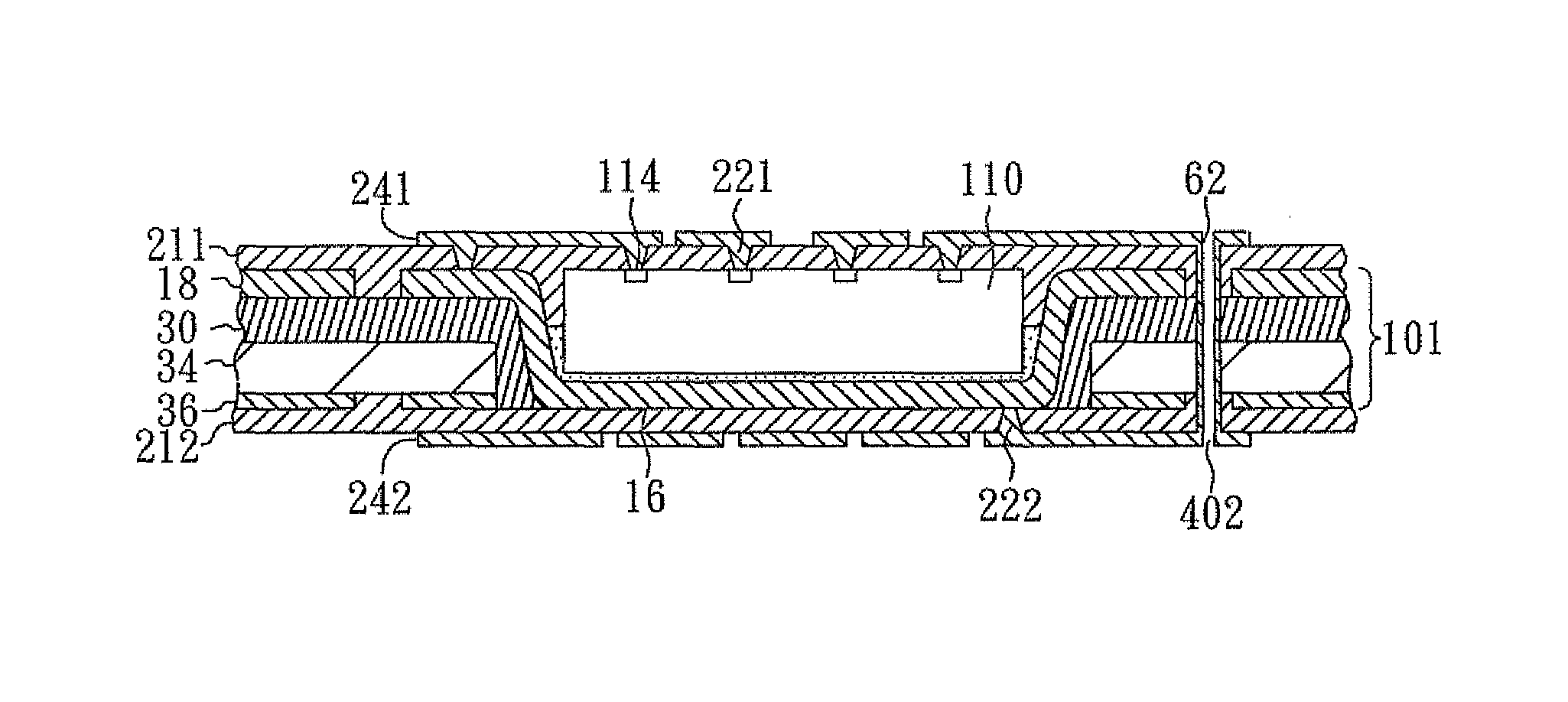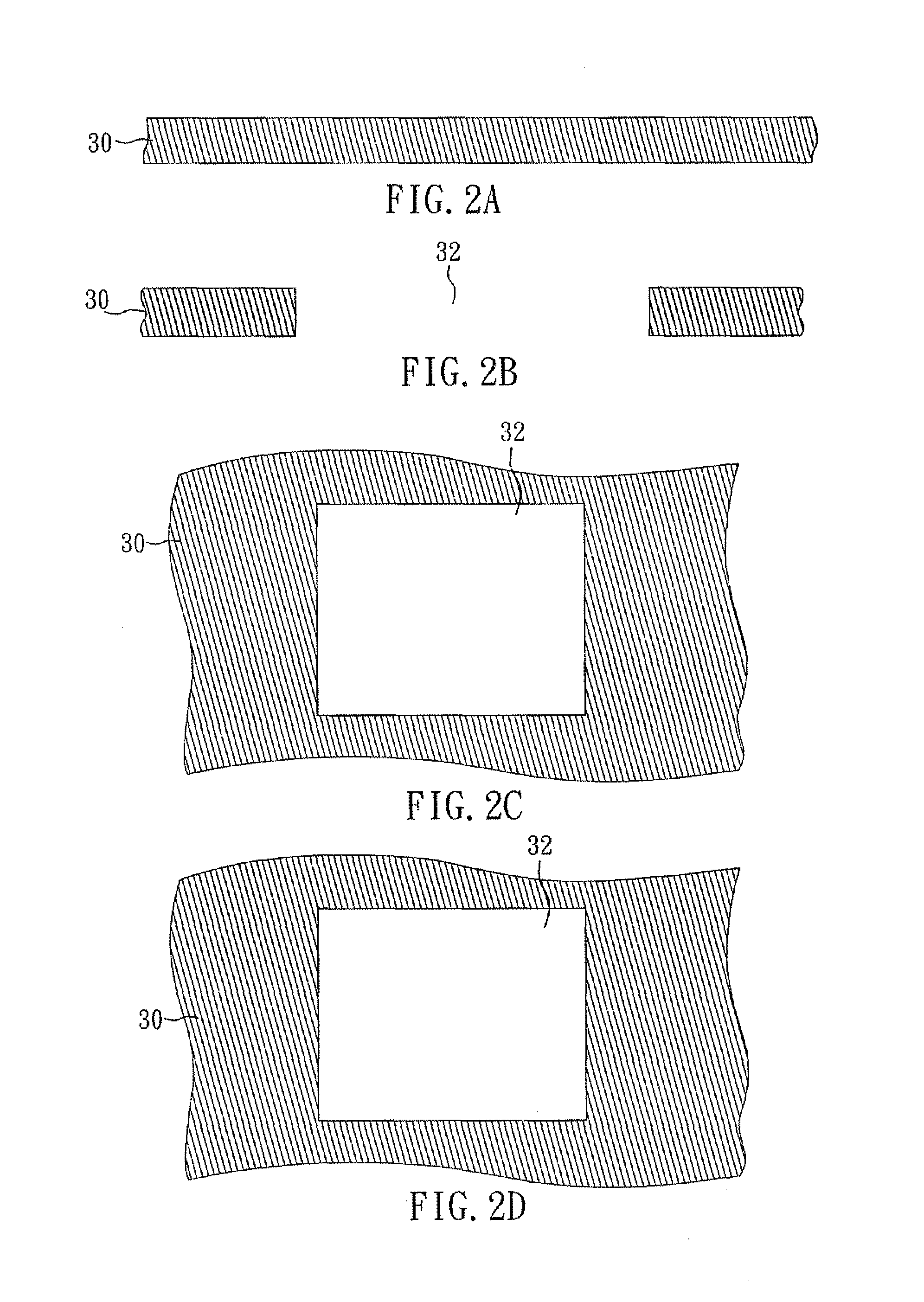Stackable semiconductor assembly with bump/flange heat spreader and dual build-up circuitry
a technology of heat spreader and semiconductor assembly, which is applied in the association of printed circuit non-printed electric components, basic electric elements, solid-state devices, etc., can solve the problems of reducing chip feature sizes, many performance-related deficiencies remain, and multiple devices stacked in a limited space often encounter undesirable inter-device noise, so as to improve thermal and electrical performance and environmental reliability, avoid likely shifting and cracking of embedded chips during lamination, and improve manufacturing yield
- Summary
- Abstract
- Description
- Claims
- Application Information
AI Technical Summary
Benefits of technology
Problems solved by technology
Method used
Image
Examples
embodiment 1
[Embodiment 1]
[0050]FIGS. 1A and 1B are cross-sectional views showing a method of making a bump and a flange in accordance with an embodiment of the present invention, and FIGS. 1C and 1D are top and bottom views, respectively, corresponding to FIG. 1B.
[0051]FIG. 1A is a cross-sectional view of metal plate 10 which includes opposing major surfaces 12 and 14. Metal plate 10 is illustrated as a copper plate with a thickness of 100 microns. Copper has high thermal conductivity, good flexibility and low cost. Metal plate 10 can be various metals such as copper, aluminum, alloy 42, iron, nickel, silver, gold, combinations thereof, and alloys thereof.
[0052]FIGS. 1B, 1C and 1D are cross-sectional, top and bottom views, respectively, of metal plate 10 with bump 16, flange 18 and cavity 20. Bump 16 and cavity 20 are formed by mechanically stamping metal plate 10. Thus, bump 16 is a stamped portion of metal plate 10 and flange 18 is an unstamped portion of metal plate 10.
[0053]Bump 16 is adja...
embodiment 2
[Embodiment 2]
[0115]FIGS. 8A-8H are cross-sectional views showing a method of making a stackable semiconductor assembly with a plated through-hole connected to inner pads of the thermal board according to another aspect of the present invention.
[0116]FIG. 8A is a cross-sectional view of thermal board 101, which is manufactured by the steps shown in FIGS. 1A-4E.
[0117]FIG. 8B is a cross-sectional view of the structure with through-holes 401. Through-holes 401 extend through flange 18, adhesive 30, substrate 34 and conductive layer 36 in the vertical direction. Through-holes 401 are formed by mechanical drilling and can be formed by other techniques such as laser drilling and plasma etching.
[0118]FIG. 8C is a cross-sectional view of the structure with first plated layer 60 outside through-hole 401 and connecting layer 62 and insulative filler 63 in through-hole 401. First plated layer 60 covers and extends from bump 16 and flange 18 in the upward direction. First plated layer 60 also c...
embodiments 3-4
[Embodiments 3-4]
[0134]FIGS. 9-10 are cross-sectional views showing stackable semiconductor assemblies wherein the thermal board is devoid of a substrate.
[0135]In these embodiments, a thick conductive layer 36 is applied and the substrate is omitted. For instance, conductive layer 36 has a thickness of 130 microns (rather than 30 microns) so that it can be handled without warping or wobbling. If a base is created, as shown in FIG. 10, base 64 and second inner pad 183 are therefore thicker, and thermal board 102 is devoid of a substrate. Accordingly, base 64 has a first thickness where it is adjacent to the bump 16 and a second thickness where it is adjacent to the adhesive 30 that is larger than the first thickness, and base 64 and second inner pad 183 have the same thickness where closest to one another and different thickness where base 64 is adjacent to bump 16 and are coplanar with one another at a surface that faces in the downward direction.
[0136]As mentioned above, adhesive 3...
PUM
 Login to View More
Login to View More Abstract
Description
Claims
Application Information
 Login to View More
Login to View More - R&D
- Intellectual Property
- Life Sciences
- Materials
- Tech Scout
- Unparalleled Data Quality
- Higher Quality Content
- 60% Fewer Hallucinations
Browse by: Latest US Patents, China's latest patents, Technical Efficacy Thesaurus, Application Domain, Technology Topic, Popular Technical Reports.
© 2025 PatSnap. All rights reserved.Legal|Privacy policy|Modern Slavery Act Transparency Statement|Sitemap|About US| Contact US: help@patsnap.com



